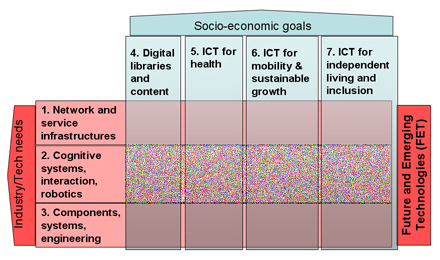|
|
FP7 ICT Work Programme Challenge 2:
Cognitive Systems, Interaction, Robotics

ICT Proposers Day, KOLN 2007 1 February 2007, Cologne
Fp7 in Motion: Cognitive Systems, Interaction, Robotics, Digital Libraries and Content 24-25 January 2007, Luxembourg
IST 2006 Helsinki 21-23 November 2007
Collette Maloney, Head of Unit “Cognitive Systems and Robotics”
Cognitive Systems and Robotics mailbox: infso-cognition@europa.eu
Directorate E: Digital Content and Cognitive Systems
Directorate General Information Society and Media
Within the Directorate General Information Society and Media, the Directorate E: Digital Content and Cognitive Systems has the following structure:
- E.1: Interaction and Interfaces
- E.2: Content and Knowledge
- E.3: Cultural Heritage and Technology Enhanced Learning
- E.4: Digital Libraries and Public Sector Information
- E.5: Cognitive Systems and Robotics
- E.6: eContent and Safer Internet
Under FP6, the categories: Multimodal Interfaces,
Semantic-based Knowledge and Content Systems,
Cognitive Systems, Advanced Robotics, Search Engines for Audio-Visual Content came under the call for call for
Knowledge and Interface technologies.
In FP7, some of these categories become Challenge 4.2: Intelligent Content and Semantics responding to calls under Challenge 4: Digital Libraries and Content.
The remaining categories become Challenge 2: Cognitive Systems, Interaction, Robotics.
Download the FP7 ICT Work Programme here.
Below on the left is the text of the FP7 calls (not including the rationale).
Below on the right are links to currently and previously funded FP6 projects.
Note only projects under Cognition and Multimodal Interfaces have been included to date.
Further information can be found on the CORDIS website.
|
|
FP7: Cognitive Systems, Interaction, Robotics
|
Artificial systems that fulfil one or both of the following requirements:
- they can achieve general goals in a largely unsupervised way, and persevere under
adverse or uncertain conditions; adapt, within reasonable constraints, to changing
service and performance requirements, without the need for external re-programming,
re-configuring, or re-adjusting.
- they communicate and co-operate with people or each other, based on a wellgrounded
understanding of the objects, events and processes in their environment, and
their own situation, competences and knowledge.
Work will result in demonstrators that operate largely autonomously in demanding and
open-ended environments which call for a suitable mix of capabilities for sensing, data
analysis, processing, control and acting; and for communication and co-operation with
people or machines or both. Where required, systems will integrate high-level cognitive
competencies; for example, for reasoning, planning and decision-making, and for active
environmental modelling.
|
|
Proposals satisfying the above requirements should focus on one of the following areas:
- Robots handling, individually or jointly, tangible objects of different shapes and sizes,
and operating either fully autonomously (as for instance in difficult terrains with a need
for robust locomotion, navigation and obstacle avoidance) or in co-operation with
people in complex, dynamic spatial environments (e.g. domestic environments).
- Robots, sensor networks and other artificial systems, monitoring and controlling
material and informational processes e.g. in industrial manufacturing or public services
domains. This may include information gathering and interpretation in real-time
emergency or hazardous situations (e.g. through multi-sensory data-fusion) or in virtual
spaces related to real world objects and people.
- Intuitive multimodal interfaces and interpersonal communication systems providing
personalised interactivity in real-world and virtual environments, based on improved
human interaction modelling and understanding of contextually-referred
communication, for example, by signs and signals in all modes (such as sound, vision,
touch) and modalities (such as natural language, both spoken and written), through
autonomous adaptation and by addressing user needs, intentions and emotions.
|
|
Work proposed in any of these areas should, as appropriate:
- develop and apply engineering approaches that cater for real-time requirements (if
present) and systems modularity, and ensure the reliability, flexibility, robustness,
scalability and, where relevant, also the safety of the resulting systems; and develop
criteria for benchmarking these properties;
- contribute to the theory and application of learning in artificial systems, tackling
issues related to the purposive and largely autonomous interpretation of sensorgenerated
data arising in different environments, and to novel design and
implementation principles of pertinent systems architectures.
- explore and validate the use of:
- advanced sensor, actuator, memory and control elements, components and
platforms, based on new, possibly bio-mimetic, materials and hardware designs –
e.g. for the realisation of systems with greater structural and functional diversity and
modularity
- new, possibly bio-inspired, information-processing paradigms, and of models of
natural cognition (including human mental and linguistic development), adaptation,
self-organisation, and emergence; and take account of the role of systems
embodiment and affordances.
- new ways of combining statistical, knowledge driven and cognitive approaches to
language understanding, generation, and translation by machines.
|
...
|
A principled approach to structuring research in relevant areas, addressing in
particular learning in artificial systems, the requirements for cognitive capacities of
robotic, interactive and language support systems, and including the development of
experimental scenarios, the development or construction of resources for experimentation,
and the development of performance metrics and definitions of autonomy levels for
artificial systems.
|
|
Co-ordination with related national or regional research programmes or initiatives.
|
|
FP6 funded projects: Knowledge and Content
Sites not active as of 1 February 2007 are indicated by (*).
Start date 2006
Cognition
|
Start date 2004
Cognition
Mulitmodal Interfaces
|
|
|
|
